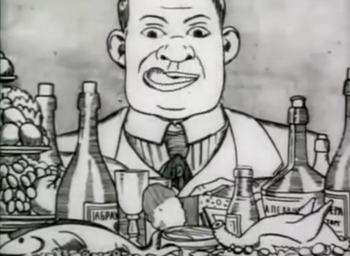Soviet Toys (1924) | Dziga Vertov
(11 min) The small Jewish film crew that produced Soviet Toys (Sovetskie igrushki, Dziga Vertov 1924), the first animated film in the Soviet Union, poured all their aspirations for stop-motion filmmaking into its production. The ten-minute short tries to show (and show-off) the potential of film to bring utopian fantasies of equality into reality. A bold self-proclamation for animation (and filmmaking in general), Soviet Toys is an artistic manifesto to the power of film to create the most modern, most enlightening, most social version of humanity possible. I often return to this film precisely because it so clearly demonstrates the faith these Jewish filmmakers poured into the belief that the core technologies of film could produce a better world. And maybe they were right, by the way. Their aspirations for Truth and Justice may have been a bit lofty, but it is worth understanding what they did do because Soviet Toys was in fact one of the films that did convince that part of the world of its core socialist vision, and convinced the rest of the world of the power of film. In a sense, Soviet Toys is a messianic work of art, although some people said it was commercial garbage, cheap propaganda, and nothing but “Jewish media”.
And in some sense, these folks were right too, especially the part where the film was selling something (in this case, art). As it turns out, Soviet Toys was literally a commercial, a fact that is either dismissed or is the only thing people remember about it. Soviet Toys is an advertisement for the Mezhrabpom studio, created by recently-arrived Jewish freelancers with a penchant for working with the new stop-motion technologies rather than “real” actors.
Created in a medium that would attract many Jewish artists seeking to build a social utopia one frame at a time, the film made history precisely because it made its main narrative points directly through the visual technology of animation. Soviet Toys, while dripping with patriotic Party lines (rendered in black-and-white cutout silent animation), was really advertising the studio as an important enterprise for the new country by crediting the new technology of stop-motion to the Revolution itself.
The film takes the literal perspective of the ever-watchful “Movie-Man,” whose eyes are camera lenses that record society and its “types” technologically – which is equated with objectivity and Truth. It makes sense then that the film communicates its main messages primarily through the special effects of stop-motion gags. The Capitalist tycoon enjoys a magically self-laid table (that slowly floats down from the sky). Ladies appear out of nowhere (the sudden inclusion of a new object into the scene). Clerics are hinged like wooden nutcracker pieces, whose mouths go up and down (metaphoric characterization). Seeing Movie-Man’s exposés of abuse, the Worker appears in a heroic crescendo and defeats the Capitalist with a pair of scissors (a reference to the government’s program to narrow the price gap between industrial and agricultural goods called the “scissors crisis”). Movie-Man arrives at the scene and physically merges with the body of the worker to extricate all that the NEP-Man consumed for himself and then to redistribute it to the people’s bank. Soldiers appear one by one and form a New Year’s tree, for which Movie-Man provides the decorative ornaments of the now-nostalgic “types” of the old-fashioned Capitalist, priest, and prostitute (who are hung from a tree). At the conclusion of the film, Movie-Man sits in a thoughtful pose behind a desk at the state film offices and turns his goggled eyes squarely on the viewer. Simultaneously a product of the Jewish folk craft of paper-cutting and simple line drawings, an icon of Russian avant-gardism, and a literal commercial, the film finds resolution to its dramatically wrought plot in its own documentary power.
Public domain. No copyright. archive.org/details/DzigaVertovSovietToys1924
Maya Balakirsky Katz is a psychoanalyst and an associate professor of Jewish art at Bar-Ilan in 2019.
Reflections
For media watch-dogs:
If watch-dogs are seeking to make media accountable in a world that has openly embraced the use of fictional genres and trick technology as essential to documentary media, what updates need to be made to classic definitions of propaganda?
For media scholars:
What characteristics about “new media” make it hospitable to artists on the margins of the art world and the artistic establishment?
For Soviet historians:
How does Soviet Toys challenge the widely-held conviction that Soviet commercials had “zero impact,” in the words of Russian arts channel producer Lyubov Platonova, on business and culture in the USSR?
Want more?
Get curated JewishArts.org content in your inbox






